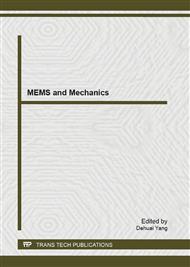[1]
D.M.van den Broek, M.Elwenspoek, Explosive micro-bubble actuator, J. Sensors and Actuators A. 145-146 (2008) 387-393.
DOI: 10.1016/j.sna.2007.11.008
Google Scholar
[2]
Rebecca Braff Maxwell, Antimony L. Gerhardt, Mehmet Toner, et al, A Microbubble-Powered Bioparticle Actuator, J. JOURNAL OF MICROELECTROMECHANICAL SYSTEMS. 12 (2003) 630-640.
DOI: 10.1109/jmems.2003.818457
Google Scholar
[3]
Wei Xua, Liang L.Wua, Yang Zhang,et al, A vapor based microfluidic flow regulator, J. Sensors and Actuators B. 142 (2009) 355-361.
Google Scholar
[4]
T. Okamoto, T. Suzuki, N. Yamamoto, et al, Microarray fabrication with covalent attachment of DNA using bubble jet technology, J. Nature Biotechnol.18 (2000) 438-441.
DOI: 10.1038/74507
Google Scholar
[5]
Ke-Min Liao, Rongshun Chen, Bruce C.S. Chou, et al, A novel thermal-bubble-based micromachined accelerometer, J. Sensors and Actuators A. 130-131 (2006) 282-289.
DOI: 10.1016/j.sna.2006.02.049
Google Scholar
[6]
Yunfei Chen, Jian-gang Weng, Jennifer R. Lukes, et al, Molecular dynamics simulation of the meniscus formation between two surfaces, J. APPLIED PHYSICS LETTERS. 79 (2001) 1267-1269.
DOI: 10.1063/1.1394957
Google Scholar
[7]
Jian-Gang Weng, Seungho Park, Jennifer R. Lukes, et al, Molecular dynamics investigation of thickness effect on liquid films, J. JOURNAL OF CHEMICAL PHYSICS. 113 (2000) 5917-5923.
DOI: 10.1063/1.1290698
Google Scholar
[8]
B.C. Khoo, E. Klaseboer, K.C. Hung, et al, A collapsing bubble-induced micro-pump using the jetting effect, J. Sensors and Actuators A. 118 (2005) 152-161.
DOI: 10.1016/s0924-4247(04)00552-7
Google Scholar
[9]
S.H. Park, J.G. Weng, C.L. Tien, et al, A molecular dynamics study on surface tension of microbubbles, J. International Journal of Heat and Mass Transfer. 44 (2001) 1849-1856.
DOI: 10.1016/s0017-9310(00)00244-1
Google Scholar
[10]
Peigang Deng, Yi-Kuen Lee, Ping Cheng, et al, An experimental study of heater size effect on micro bubble generation, J. International Journal of Heat and Mass Transfer. 49 (2006) 2535-2544.
DOI: 10.1016/j.ijheatmasstransfer.2005.12.016
Google Scholar
[11]
S.J. Lind, T.N. Phillips, Spherical bubble collapse in viscoelastic fluids, J. Journal of Non-Newtonian Fluid Mechanics. 165 (2010) 56-64.
DOI: 10.1016/j.jnnfm.2009.09.002
Google Scholar
[12]
Li Weizhong, Chen Chong, Yang Jian, et al, A MD study on diffusion coefficient of L-J liquid and its relation with temperature, J. Journal of Thermal Science and Technology. 5 (2006) 101-105.
Google Scholar
[13]
Liu Xiumei, Hou Youfu, He Jie, et al, Temperature effect on the behavior of a laser induced cavitation bubble, J. Journal of Optoelectronics Laser. 21 (2010) 791-794.
Google Scholar


